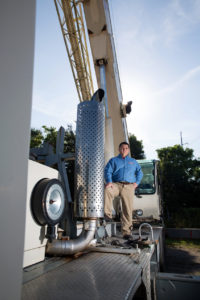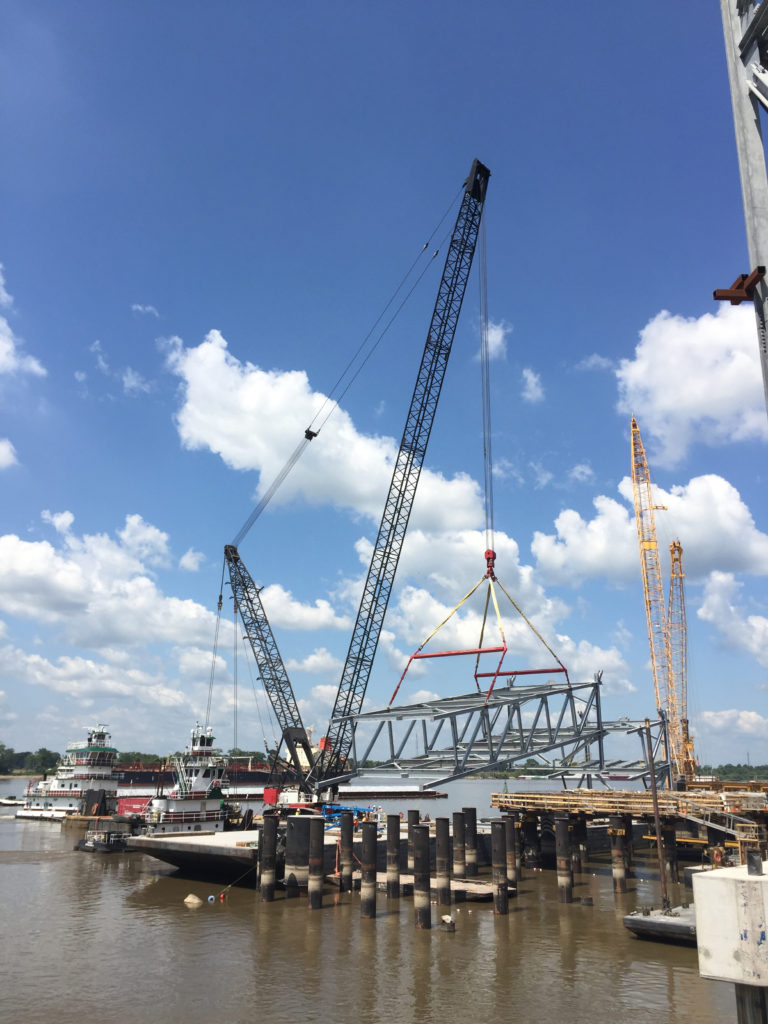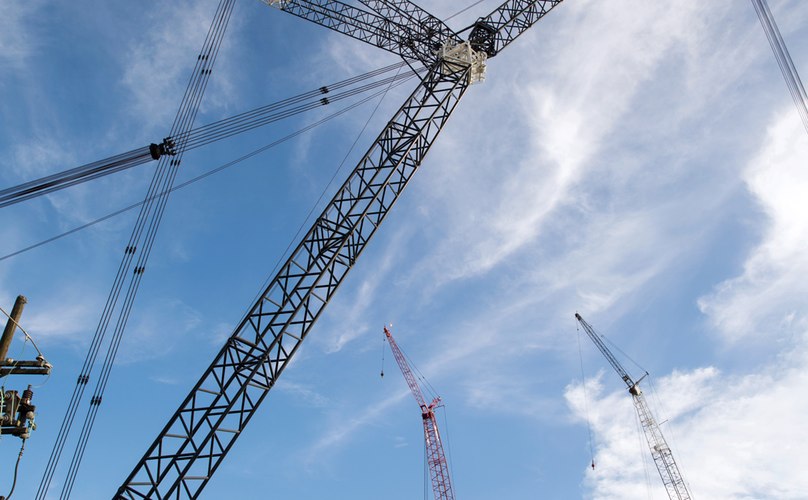As industrial owners design vessels and structures that are heavier, taller and in increasingly tighter spaces, the facilitators of their installations—the heavy lifting industry—have learned to adapt and differentiate to remain competitive. This summer, staying lean has also been the name of the game, as crane and rigging operators say an expected influx of work has never materialized.
“This year has been a challenge,” says Jeremy Landry, project manager with Deep South Crane and Rigging in Baton Rouge. “We’ve had a very slow summer. We had a lot of projects that were supposed to happen this year but got canceled. We’re coming through one of the slowest summers that we’ve ever seen.”
According to Business Report, Much of the slowdown is due to the depressed oil and gas market, and contrasts sharply with expectations—2016 was originally forecast to be a record year. This makes differentiation a driving force in such a highly competitive, low-profit-margin environment. The number of heavy lift and haul companies in Louisiana has trended upward in recent years in anticipation of the $140 billion in announced industrial projects since 2012.
“I counted 15 crane companies in the Baton Rouge area,” Landry says.
Heightened safety standards are also topping the list of priorities, as owners ramp up safety protocols in light of recent high-profile crane accidents across the U.S. and abroad. This has led to an intensified industrywide effort to improve safety standards. In July, the National Commission for the Certification of Crane Operators, a nonprofit organization that develops performance standards for safe crane operation, announced that applications for NCCCO Certified Lift Director examinations are running at more than double the regular pace.
“Registrations received in the first three months of this year have been far ahead of expectations, and inquiries from prospective candidates and employers have spiked,” says NCCCO Director of Program Development Joel Oliva in a recent press release. OSHA’s increased emphasis on the need for lift directors in the planning and execution of crane operations has been the catalyst for the increased interest. The requirement is also more frequently finding its way into bid documents.
Oliva said that there are moves afoot to require that lift directors play a more prominent role in crane operations following the publication of a report by a technical review group in the wake of a fatal New York City crane collapse in February.
STANDING OUT
In the heavy lifting industry, differentiation usually comes in the form of new technology and proprietary processes.
“It’s a function of what we see in the field, along with the bid packages that come across our desk and what they require,” Deep South’s Landry says. “If you don’t have that size crane, then obviously you can’t bid. Then, it’s a function of your competition. What does your competition have? Do they have one that big? If the answer is yes, then you want to be able to provide all the services that your competition can.”
Mark Polson, project sales with Barnhart Crane & Rigging in Gonzales, says his company—while large nationally—is relatively new to Louisiana. Barnhart’s target market in the state is the removal and replacement of vessels within existing plants. Polson has an engineering degree from LSU and has worked in the industrial market for 20 years.

GAINING AN EDGE: Polson feels that Barnhart’s size and national scope, as well as its lower mobilization costs, give it a competitive edge. (Photo by Collin Richie)
“It’s coming in, getting those difficult to reach, difficult to access vessels, compressors, etc., and getting them out,” he adds. “We think that’s where we can offer value. If it’s easy, that’s probably not one of our targets. We can quote it, we can do it, but if it’s easy anyone can do it.”
It’s especially important for a newcomer to stand out from the crowd, and Polson feels that Barnhart’s size and national scope, as well as its lower mobilization costs, give it a competitive edge. The contractor’s network of branches enables it to station cranes across the U.S., leading to reductions in the cost to mobilize a large crane for a project.
“While we have a large engineering group, it’s more than just that,” Polson says. “For the challenging projects, we’ll likely have a project guy from somewhere who has had to work something similar.”
Barnhart conducts a series of brainstorming sessions to examine options and develop a plan of action, bringing in others from across the company to provide input. During the meetings, Barnhart team members share experiences, lessons learned and SOPs (standard operating procedures) to develop the best plan of action.
“Yesterday, I was here in Gonzales, but there was someone from Mobile, two engineers from our Memphis branch, and someone from the Chicago branch, all in the same meeting, because they had input to provide. We all came together to determine how best to use the knowledge of the company specific to this application.”
THE SAFETY FACTOR
Dustin Brown, director of safety and human resources at Bengal Industries in Geismar, says OSHA regulations governing the crane and rigging industry, issued in 2010, have placed a greater emphasis on certifications not only for operators, but also “anyone who touches a crane.”
The OSHA rule replaced a decades-old standard (last updated in 1971) and addresses critically important provisions for crane operator certification, crane inspection, set-up and disassembly, and was designed to prevent the leading causes of fatalities, namely electrocution, crushed-by/struck-by hazards during assembly/disassembly, collapse and overturn.
In the last five years, there has been an increased emphasis on lift planning and task designations, such as lift director and assembly/disassembly director. As such, finding the necessary skilled craftsmen has been a challenge given the current labor shortage.
“Not a lot of people realize it but these new cranes are full of technology and computer driven,” Brown says. “It’s not the friction rigs from 20 years ago. Because of that, there’s more specialized training required. You have to have specialized mechanics that can diagnose these problems, and understand computer, electrical and hydraulic systems.”
Of course, every contractor’s safety record is directly tied to profitability, and in the crane industry accidents can be catastrophic. “Therefore, crane companies carry a great deal of liability, not only for the items that might be lifted but for the complete area around the lift,” Brown says. “If you fail to have the right insurance in place, that can be a very devastating blow if you have an uninsurable loss on a crane.”
Barnhart’s operators and riggers carry qualification cards, or Qual-Cards, which is the company’s stamp of approval that a person is qualified to safely operate a piece of equipment. Polson says Barnhart also practices “tactical self-preservation,” which means having a detailed, comprehensive plan of action intended to prevent injuries to property or workers. The responsibility is placed on the individual to take initiative before a task to develop a detailed, specific plan that protects themselves and others from harm.
Starting with a pre-job hazard analysis, Barnhart crews scout the site for potential hazards and implement systems to deal with those hazards. Additionally, in the performance of their job, any Barnhart employee can stop a job without fear of reprisal.
Deep South hired an ex-ExxonMobil employee to revamp its safety program. “We put a lot of time and effort into training our people,” Landry says. “It’s a big expense, but at the end of the day it’s worth it. If you don’t have a good safety culture, you can have all of the procedures and documentation you want, but if the people don’t buy into it you’re not doing anything.”
Deep South takes particular care to monitor wind speeds during heavy lifts. “If the wind is projected to be a certain mile per hour or above, we lower our cranes and halt the lift.” Anemometers are mounted on the cranes for the operators to monitor, and operations are halted when winds reach 40 to 45 mph.
TECHNOLOGICAL ADVANCES
When Deep South Crane sees a need for a new crane, it relies upon its four-person engineering staff to craft a solution, then its in-house fabrication and testing team finishes the job. Deep South designs and manufactures its own crane line—VersaCrane—with nearly 300 cranes in inventory ranging from 8 tons to 2,500 tons in capacity. “The cranes have gotten bigger, more extravagant and more technical to keep up with the market,” Landry says. “Right now, we’re fabricating a 3,500-ton machine, which will be the largest we offer.”
During the design and manufacturing process, all welds endure a nondestructive test that meets industry standards. Once the crane is complete, it is subjected to a rigorous testing process that meets the ASME standard for cranes and derricks. A third-party consultant is also used to verify that the crane meets code. The entire process from conception to design to completion and testing takes approximately two years.
“Perhaps most unique is our cranes’ hinged counterweight system,” Landry says. “Most cranes come with a main counterweight and an auxiliary counterweight system. With the hinged system, we have a more compact tail swing than most other cranes in that category.”
As such, the VersaCranes are designed to work within the tight confines of a functioning petrochemical plant.
Deep South also recently opened a 30,000-square-foot fabrication shop in DeQuincy, Louisiana, equipped with a $1 million, state-of-the-art robotic loading machine that enables it to weld around the clock. At the facility, the company manufactures steel crane mats, an alternative to the more commonly used wood mats. About 400 of the mats have already been fabricated, with a goal of 1,000.
The steel mats weigh about the same as a wooden mat, but can more easily distribute the load and have greater longevity. Eventually, Deep South plans to also begin fabricating crane components at the facility.
Highlighting Barnhart’s technological portfolio are its moveable counterweight rigging system and “tri-block” rigging system. Polson says the moveable counterweights make cantilevered operations more efficient and easier to perform, and are especially useful when avoiding obstructions through lateral movement. During operation, the remote-controlled counterweight can easily be adjusted to balance load. The tri-block system enables the contractor to “self-tail” equipment in tight work areas, without the use of a second, tailing rig.
SAM BARNES

BIG AL: Barnhart Crane & Rigging now has its 400-ton barge crane, “Big Al,” home-ported in Louisiana. (Photo courtesy of Barnhart)




